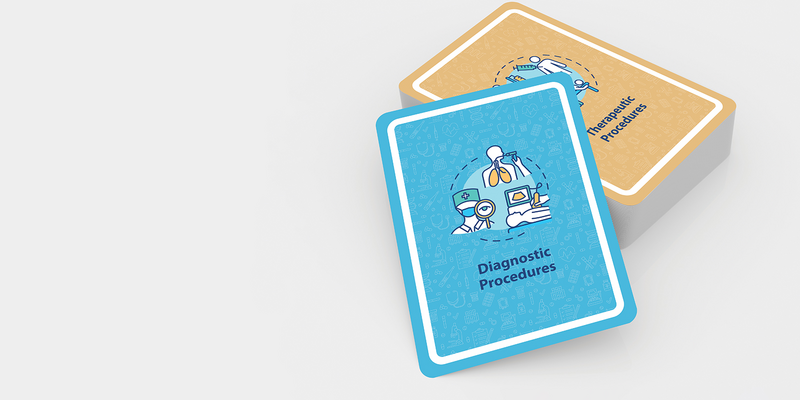TD Magazine Article
Medical Training Can Be Fun and Games
Board, card, and video games have enhanced medical and surgical education.
Mon May 02 2022

Bookmark
Since the early 20th century, medical and surgical education as it exists has been built on the foundation of experiential learning—namely learning by doing. For centuries, physicians learned through apprenticeship and coining the phrase "See one, do one, teach one." That model exists to some extent today, but major pushes for patient safety and quality have limited the ability to train physicians through pure experience on actual patients.
The addition of the 80-hour workweek also limited physicians' time in the hospital and thus less time with patients and in surgery than decades prior. Two to three decades ago, medicine and surgery turned to simulation to fill the training gap, enabling trainees to practice on physical devices and in specific high-risk scenarios to prepare themselves better for when they encounter real patients and cases.
Physical simulators and task trainers were the mainstays of those innovations but were limited by their cost and need for physical space in simulation centers. The limitations amplified due to the COVID-19 pandemic that resulted in access to those centers being restricted for nearly 18 months and ongoing. That crutch for training programs disappeared, and clinical experience was at risk for many training programs.
The acceleration brought about by the pandemic shines a bright light on many of the inefficiencies in current surgical education regarding training tools outside the operating room. Besides the technical challenges, there exists better informed theory and ideas about how people learn.
Some learning theories borrowed from the K–12 and secondary education literature have entered the healthcare space. For instance, concepts of adult learning theory, cognitive load theory, novice-expert shift, zone of proximal development, spaced repetition, and deliberate practice have made their way into the medical education literature. Many reforms in training programs have entailed integrating those theories and focusing on more problem- and case-based active learning exercises. During the pandemic, many training programs had to be flexible and creative to maintain active learning sessions over teleconferencing software.
All those factors have led to greater emphasis on the role that technology can play to fill the many gaps that exist. Advanced technologies have been increasingly gaining attention during the past decade, specifically so-called extended reality (XR), which includes virtual reality, augmented reality, and mixed reality. Because many of such technologies are still in their infancy, their realized impact remains to be seen.
Game-based learning
Along with the technologies, there has been a massive boom in the world of video games for purposes other than entertainment, often termed serious games. Games are not just for kids anymore. The latest numbers reveal that there are about 2.8 billion players worldwide, and the average age of players is about 35 years old. New companies are popping up daily, promising to create gamification of training and marketing materials and improving onboarding, training, and employee and customer engagement.
According to the British Museum, games have been around for millennia, with the Royal Game of Ur board game dating back 4,600 years in ancient Mesopotamia. The fundamental characteristic of games is they are fun to play. There's an influx of games into our everyday lives—on our phones, in our exercise apps, and in the grocery store.
What may not be apparent on the surface is that game designers are well versed in psychology, sociology, reasoning, and logic. The game psychology itself is deeply rooted in the science of motivation, operant conditioning, reward pathways, educational psychology, constructivism, and behavioral economics.
Games are fun to play, and players often learn the rules and create strategies almost seamlessly without any tutorials or reading a manual. That is not by accident. Designers deliberately aim to motivate players to start and continue to play the game, all while learning strategies based on physics, logic, and reasoning and solving problems through trial and error. Designers leverage several cognitive learning theories including the concept of flow, deliberate practice, regime of competence, and retrieval practice.
Much of education has traditionally been extrinsically motivated, meaning some gain outside the pure interest or enjoyment of the activity itself. Games are by design intrinsically motivated. Games are an opt-in experience, and they wouldn't sell well unless players were motivated to play for hours on end. Such theory-informed designs make game-based learning exciting.
There is huge excitement about bringing the power of games to healthcare education and potentially using these technologies along with XR innovations to create more meaningful and impact-making advancements during a time of decreased patient exposure and limited simulation hardware access.
Game engines
Beyond the psychology, games use powerful tools called game engines to create the software, taking advantage of the most cutting edge of computing capabilities. The engines are immensely powerful to automate creation of hyper-realistic scenarios, lighting, physics, and object interactions. If you have seen how characters have evolved in video games from Super Mario Bros. all the way to Modern Warfare or Call of Duty, you will see the tremendous advancements of character animation and realism, and that is in a $50 video game. Compare that to the most advanced physical simulator or surgical simulators that are upwards of hundreds of thousands of dollars.
Those game engines can create hyper-realistic surgical and medical models on which to train. Such software-based solutions, sometimes along with the advanced technologies of XR, negate the need for physical simulators for some resident and student training. Software-based solutions will likely never replace physical simulation or patient cases, but the question is how can medical professionals leverage the technology and psychology of games to augment and supplement existing training paradigms?
It is all well and good to use games in medical education, and there is the evidence that they make a difference. For example, "Serious Gaming and Gamification Education in Health Professions: Systematic Review" found 27 randomized control trials that collectively showed evidence for improved learning outcomes and learner satisfaction effectiveness of serious gaming and gamification for health professions education as compared to traditional learning methodology. Some even resulted in improved patient outcomes as well.
Another benefit of games is that they give constant, specific, and actionable formative feedback without being overtly obvious. Assessment has been a huge point of discussion in medical education and surgical education and specifically focused on the difficulty to give genuine, context-specific, and actionable feedback to trainees.
Computer games
In practice, several companies and institutions have used game-based learning to teach a variety of subject areas ranging from managing sepsis to understanding flow through an emergency room.
In 2014, physicians at Stanford University introduced Septris, a simple computer game designed to teach principles of sepsis resuscitation in the intensive care unit. In this game, players have two icons of patients on-screen that slowly over time drift toward the bottom, essentially communicating clinical worsening to players. They run tests and order interventions to slow the decent and even reverse the characters' direction.
Players win the game by keeping the patient alive and properly treating the condition. That enables trainees to deliberately practice through trial and error with a large number of virtual patients, thus making decisions more rote when presented with these quite sick patients in the ICU.
Gistalt is a creative, straightforward mobile video game that trains emergency medicine residents to "hone your gut feeling about a patient—that sense of whether they're sick or not sick." The game presents a virtual clinical scenario of a patient, and based on the players' experience and intuition, they make a series of clinical decisions and critical next steps with a binary sort (this or that) interface. That may entail deciding whether the virtual patient is sick or what critical next step is required for the patient. The exercise strengthens type 1 thinking and pattern recognition and triggers type 2 thinking that at times is of paramount importance in the emergency room.
Table Rounds is an innovative way for students and trainees to create mental models and connect seemingly disparate facts about signs and symptoms and various medical conditions. This connection-based game enables players to connect many elements of prior knowledge (especially tacit knowledge), thus strengthening their longterm memory and improving knowledge access.
In the game, players receive square virtual cards that have four sides, each labeled with random different diagnoses, clinical signs, symptoms, or test results. They then connect the labels with adjacent cards based on some knowledge about a disease or clinical condition. They build out an explicit map of their mental models, thus retrieving and activating tacit prior knowledge and linking it, creating a virtual network of knowledge.
A final example is Airway Ex, which trains players on fiberoptic intubation through a series of virtual difficult-airway patients. The game requires users to direct a fiberoptic scope using on-screen controls that mimic the controls in real life. It enables players to practice different strategies and techniques prior to needing to do so in a critical, real-life scenario.
Board games
Beyond video games, board games have been successful in the serious games category. Teresa Chan and colleagues have several game titles, including GridlockED that teaches about "the intricacies of managing multiple patients simultaneously and about working in a resource-limited environment." During each turn, players draw cards that represent new patients or chance hospital-based events, and they must try to manage patient flow through the emergency room and the hospital's resources.
Empiric is a creative card game that teaches students and trainees about antibiotic therapies. Some cards represent infections and others represent antimicrobial medications. During each turn, players "clear" infections with their available treatment cards and then draw cards, getting points for how well they manage the board. It is a great example of how students needing to learn and apply basics of pharmacology and bacteriology to succeed in a game is likely to lead to better knowledge retention and future problem solving than rote memorization and regurgitation on tests.
Challenges
Unfortunately, medical professionals do see XR and games improperly used in medical education. There is a tremendous amount of hype around games and technology, which has led to poor implementation and resulted in less-than-ideal learning outcomes. They likely derive from the use of technology for technologies' sake; the huge boom in funding and interest in this area can exacerbate this phenomenon.
The poor results can be due in part to the use of superficial game elements such as competition and leaderboards without leveraging the deeper psychology that makes games so successful. There's also XR utilization that does not respect the tremendous amount of cognitive power applied to just engage with this platform that, in fact, detracts from the learning experience instead of being a value-add.
Opportunities abound
Many hospitals and institutions are starting to realize the potential for game-based learning among their healthcare professionals. Many projects remain small and limited in scope to certain departments and clinicians who are interested and curious about small-scale and prototype solutions. Medical professionals don't have a good handle on what the landscape looks like, but everything ranging from handwashing to physical activity to onboarding nurses and clinicians is ripe for opportunities using game-based learning.
As games and XR continue to get infused into the medical education and surgical education spaces, game developers must properly leverage all the psychology and technologies to change the motivational patterns of medical education and properly cater to how people learn.
The future of surgical training is likely a hybrid solution involving totally asynchronous (learning on their own), synchronous remote (learning with others through teleconferencing), and synchronous in-person training. Technology and games can help train surgeons long before they ever are with patients in the operating suite and bring them higher on the learning curve to be the most efficient and efficacious with their training. The future is bright, but we need to remain vigilant to create experiences that provide value to the training experience instead of using technology for technologies' sake.

More from ATD
